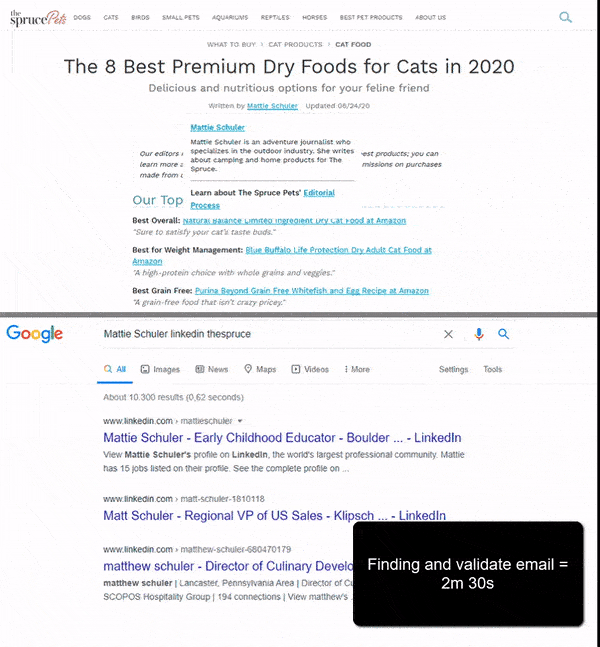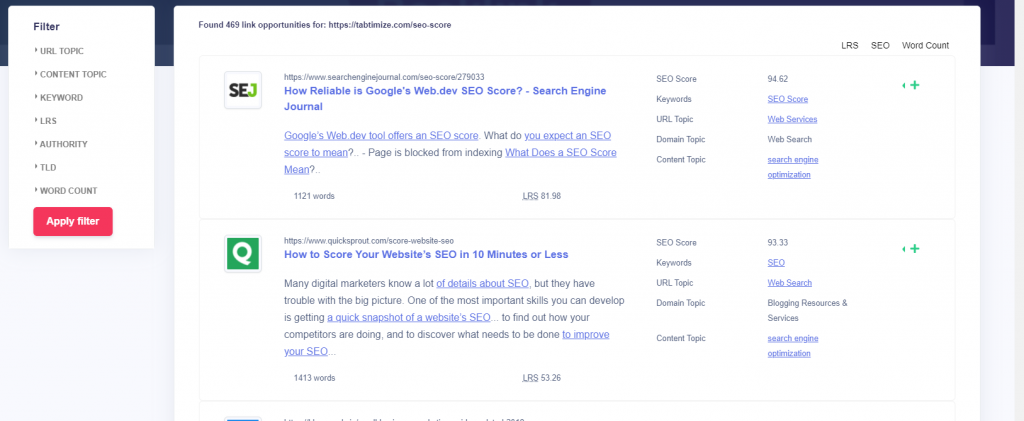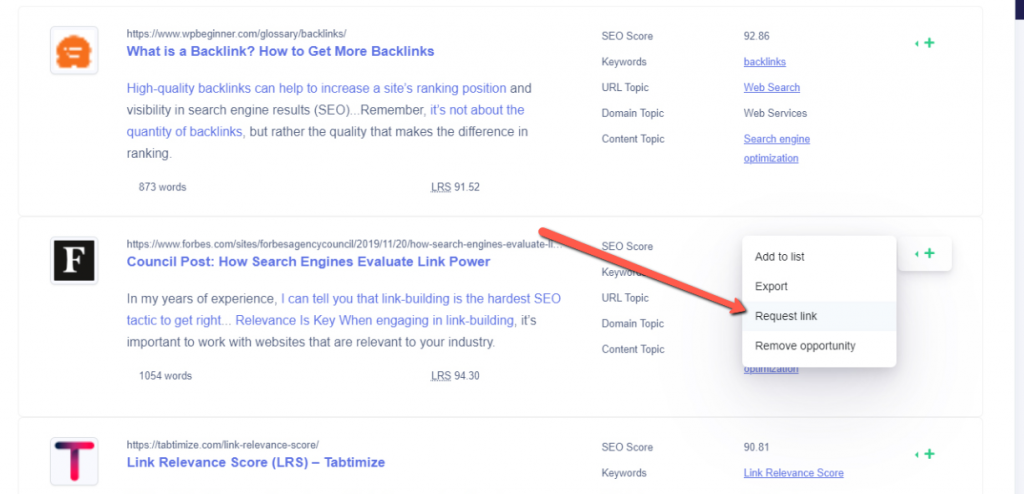It’s actually quite simple.
Just follow the list below and you’ll be well on your way:
- Enter the keyword/topic into Google you want to find link opportunities for.
- Open each result in a new tab.
- Read through all the pages and make an educated guess where on the page it might make sense to get a link from.
- Save each relevant link opportunity in a spreadsheet, with the URL, related keywords/topic, where on the page the link should be linked from, and an anchor text.
- If you want to reach out to these link opportunities, then you must also find one or more relevant email addresses of the people you want to get in touch with.
- To make sure you have the correct contact information, just cross-reference it on any social media platform, preferably LinkedIn, to see if it’s correct.
Repeat steps 1-6 at least hundreds to thousands of times, to make sure that, statistically, you have high enough chances of getting any contextually relevant links.
There must be a better way, right?
Thankfully yes, and that’s what we’re going to talk about in this post. But before we get into it, let’s look at the numbers behind the “traditional” way of finding RLOs (relevant link opportunities). Prepare to be surprised.
How long does it take to find contextually relevant link opportunities?
The “traditional” 6 step approach is an excellent way to get started building contextually relevant backlinks, but it’s definitely a time consuming and mentally draining practice. In fact, this method takes around 4 minutes on average per link opportunity, not including the time it takes to do your own keyword/topic analysis and outreach.
Below is a basic example where I try to find relevant link opportunities for a blog on cats. The topic is cat nutrition. Doing steps 1-6 took me 3 minutes and 45 seconds.

With an average hit rate between 3-5% (sources 1 & 2), you will be able to get a backlink every 1 hour and 20 minutes at best, and only with the use of automated outreach software. Just think what it will take to beat the top 5 spots in SERP for your niche in terms of the number of backlinks…
Now I do not know your specific competitors or niche, but I would assume that it will take you a lot more time than you’d ideally like to spend.
For example, it will take 133.33 hours to build 100 links on average.
Here is how its calculated:
(100 (number of backlinks) * 80 (the average number of minutes to build 1 backlink)) / 60 (number of minutes per hour) = 133.33 hours.
Want to find out how many hours getting as many backlinks as your competitors will take?
Try it out for yourself in the calculator below:
The better way to find contextually relevant link opportunities
We now come to what you have been waiting for, the easiest way to find contextually relevant link opportunities.
Artificial intelligence is becoming a norm in almost everyone’s day to day life. Smart speakers, smart cars, and smart ‘anything’ that make our lives that much easier. So why should it be so ridiculously time-consuming to find contextually relevant link opportunities?
Fortunately for all of us, there is now a much (and I mean much) easier way to find relevant link opportunities.
Luckily, you also do not have to go very far to find the easy way. It’s all inside the Link Opportunity feature, which you can find under the ‘Backlink Engine’ menu on Tabtimize.

The Link Opportunity feature does all the hard work for you.
It reads the main content of web pages and analyzes the content with many different NLP models. It finds various essential data about the content, such as keywords, topics, contextual understanding, semantic understanding, and more. With all that data, the machine can find a contextual connection between all pages in the database and only match the relevant ones.
Also, it uses a relevance metric (Link Relevance Score or LRS) that quantifies the relevance analysis between two pages so that you can understand the degree of relevance between them.

This basically means that the machine will do everything for you in terms of determining if a page is relevant to yours. You can also use the LRS metric to compare and sort link opportunities by the degree of contextual relevance they have to your page.
But what about the anchor text?
The anchor text is usually always mentioned as an essential part of understanding what a link refers to. In other words, the anchor text must tell both the users and Google what the content of that link is about. This helps users and Google to determine if the link is relevant to follow.
Therefore, one of the most important tasks in finding relevant link opportunities is also deciding on an anchor text.
Fortunately, this is also something that the Backlink Engine takes into account in its two-page relevance match. In each link opportunity result, you can see a short snippet of a text containing one or more “links” with blue marking. It symbolizes a possible anchor text that can be used If these two pages are to be linked with each other.

So not only does it read and link the pages by keyword, topic, and semantic relevance, but the machine also suggests anchor texts for you. Basically, there’s nothing you have to do (manually) to analyze the relevance of the pages.
Okay, a text savvy machine that can link relevant pages to my page, I get that, but what about the whole personalization thing and finding the right contact information?
Getting the right contact information, the AI way
When you find the page or pages you want to use for your outreach, you have the possibility to simply click on the red plus button and select the Export button.

However, if you want to do the outreach yourself, you can always add the opportunities to a list, export them to a CSV file, and do the outreach by yourself.

You can actually find out just how many hours it would take to find the same amount of contextual relevant link opportunities as your competitors by entering the number of backlinks that you entered in the first calculator in the “number of backlinks” field below.
How did we calculate it?:
((number of entered backlinks) * 0,5 (the average number of minutes to build 1 backlink with Tabtimize)) / 60 (number of minutes per hour) = XX hours.
An average time-saving percentage of 99.38% compared to the “traditional” way. Neat right?
Get your contextual relevant link opportunities without the hassle
Whether you want to do all the link building yourself, taking on all the hassle that comes with the research, outreach, and link building management, or whether you just want to do one of the ways yourself, link building is still an ultra time-consuming process. Making the process smarter will save you a lot of time and energy, and ensure your efforts aren’t wasted.
For the majority of us, it’s easy to see the benefit of using the Tabtimize method to find contextually relevant link opportunities. Who wouldn’t want to save 99% of their valuable time finding relevant link opportunities, right? It’s all about working smarter, not necessarily harder.
Did you know, it’s completely free to sign up for Tabtimize and start building contextually relevant link opportunities right away?
Click below to check it out:
Get contexutally relevant link opportunitiesFinal thoughts
You can save a lot of time if you use the right tools and methods to find and build contextually relevant backlinks. Over 99% (99.38% to be exact) of the time you spend on traditional link building research, can be simplified by using Tabtimize’s Link Opportunities feature. If you also use a smart tool to find content gaps and other content-creating options then you will be able to further optimize your time and efficiency.
I’m curious about other methods to find relevant link opportunities, so if you have a method you think is worth sharing, feel free to include it in the comments below.



